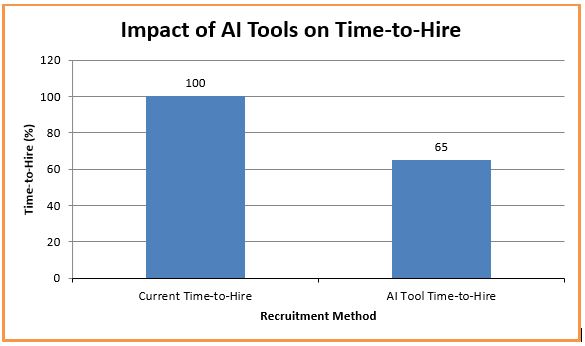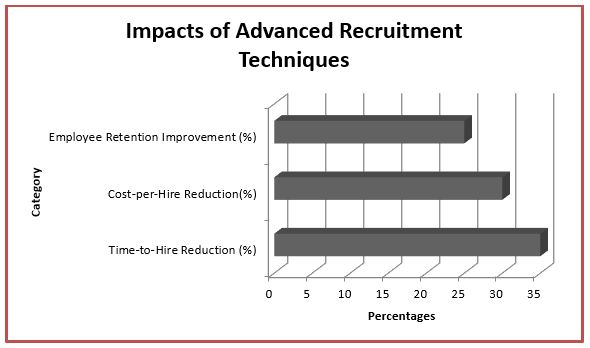|
Getting your Trinity Audio player ready...
|
In today’s fast-paced business environment, digital transformation is no longer optional—it’s essential. By leveraging cutting-edge technologies, companies can revolutionize their staffing processes, leading to better hires, improved efficiency, and increased competitiveness. Take a closer look at how staffing is being revolutionized by Digital Transformation.
Enhanced Recruitment Process
To transform recruitment and achieve exceptional results, enterprises can harness the power of AI tools. By implementing AI-driven solutions, agencies can reduce their time-to-hire by up to 35%, thanks to chatbots that streamline initial candidate screening and predictive analytics that identify top talent.

Moreover, with 75% of job seekers evaluating an employer’s brand before applying, focusing on a strong employer brand is crucial. Organizations that embrace a data-driven approach are 3x more likely to see significant improvements in decision-making. Enhancing the recruitment process further, mobile-friendly application designs and virtual reality (VR) office tours can significantly increase engagement and efficiency, making the hiring process smoother and more effective. By adopting these innovations, companies can streamline their processes and achieve outstanding hiring outcomes.
To enhance recruitment processes, companies can leverage AI-powered tools such as chatbots for initial candidate screening and predictive analytics to identify top candidates. Implementing mobile-friendly application processes and using virtual reality (VR) for virtual office tours significantly improves the candidate experience by making applications more accessible and engaging. For data-driven decision-making, agencies should utilize predictive analytics to forecast hiring needs and machine learning algorithms to precisely match candidates to roles. These strategies not only streamline the recruitment process but also create a more efficient and enjoyable experience for candidates, ultimately leading to better hiring outcomes.
How Digital Transformation is changing the game for Enterprises?
- Enhanced Recruitment: Advent managed to reduce the hiring time by averaging 3 business days from requisition to resume submission
- Reduces Time-to-Hire: Advanced tools like AI chatbots and predictive analytics streamline the recruitment process, allowing you to fill positions more quickly.
- Improves Quality of Hires: By using data-driven insights and targeted strategies, you can better match candidates to roles, leading to higher-quality hires who fit the job requirements and company culture.
- Improved Candidate Experience:
- Attracts Top Talent: A smooth, engaging application process—such as mobile-friendly forms and virtual reality (VR) tours—makes your company more appealing to top candidates.
- Enhances Employer Brand: A positive experience reflects well on your brand, helping to build a strong reputation and attract even more high-quality candidates.
- Data-Driven Decision Making:
- Reduces Hiring Costs: By using analytics to refine your recruitment strategies, you can minimize costs associated with prolonged hiring processes and inefficient methods.
- Improves Retention Rates: Data-driven insights help you make informed hiring decisions, which can lead to better job fit and higher employee satisfaction, reducing turnover.
- Flexible Workforce Management:
- Increases Employee Satisfaction: Flexible scheduling and remote work options can lead to higher employee satisfaction and better work-life balance.
- Expands Talent Pool: By offering more flexible work arrangements, you can tap into a broader and more diverse talent pool, including candidates who may not be available for traditional roles.
- Enhanced Employee Retention: Advent Global managed to attain a 17% negative attrition rate for a client.
- Reduces Turnover Costs: Effective retention strategies, supported by data and analytics, help you keep valuable employees and lower the costs associated with turnover and recruitment.
- Improves Overall Productivity: Happy and engaged employees are more productive, contributing to a more efficient and successful organization.
Overcoming Digital Transformation Challenges
1. Data Privacy Concerns:
Protecting sensitive information is crucial in the digital age. Implementing robust cyber security measures—like strong passwords, encryption, and regular security updates—helps safeguard your data from breaches and cyber threats.
Key Strategies:
- Strong Passwords: Create complex, unique passwords for different systems and accounts. Strong passwords should be long and include a mix of letters, numbers, and special characters. Implement multi-factor authentication (MFA) to add an additional layer of security.
- Encryption: This technology transforms data into a secure format that is unreadable without the correct decryption key. Encrypt data both at rest (stored data) and in transit (data being transmitted) to prevent unauthorized access. For instance, encryption secures online transactions and sensitive communications.
- Regular Security Updates: Software and systems can have vulnerabilities that cybercriminals exploit. Regular updates and patches fix these vulnerabilities, protecting against emerging threats. Automated update systems can keep your software up-to-date with the latest security fixes.
- Data Privacy Policies: Develop and enforce policies for how data is handled, stored, and shared. Ensure compliance with relevant regulations such as GDPR (General Data Protection Regulation) or CCPA (California Consumer Privacy Act), which establish standards for data protection.
Benefits:
- Reduces the risk of data breaches and financial loss.
- Builds trust with customers and partners by showing a commitment to data protection.
2. Employee Adaptation:
New technologies can be daunting for employees. To ease this transition, provide comprehensive training and ongoing support. This helps staff become familiar with new tools and ensures they feel confident using them, which can improve overall productivity and morale.
Key Strategies:
- Comprehensive Training: Provide thorough training sessions on the new technology’s features, functions, and benefits. Training should include hands-on practice and real-life scenarios to help employees understand how the new tools fit into their daily tasks.
- Ongoing Support: Offer continuous support through help desks, online resources, and dedicated personnel who can assist with any issues or questions. Set up a knowledge base with FAQs and troubleshooting guides for additional assistance.
- Change Management: Implement change management practices to guide employees through the transition. Clearly communicate the reasons for the change, how it will benefit them and the organization, and what support will be available.
- Feedback Mechanisms: Create channels for employees to provide feedback on the new technology. Address their concerns and make necessary adjustments based on their input to enhance the user experience.
Benefits:
- Helps employees quickly adapt to new systems, reducing resistance and frustration.
- Boosts productivity and job satisfaction as employees feel more confident and capable.
3. Integration with Existing Systems:
Bringing new digital tools into your current setup can be challenging. It’s important to choose solutions that are scalable and compatible with your existing systems. This way, you can ensure that everything works well together without causing disruptions or requiring extensive adjustments.
Key Strategies:
- Scalable Solutions: Choose digital tools that can grow with your organization. Scalable solutions can handle increasing amounts of data and users without sacrificing performance. For example, cloud-based platforms offer flexibility and scalability.
- Compatibility: Ensure that new technologies are compatible with your current systems and software. Conduct thorough testing to identify potential issues before full implementation. This may involve using integration platforms or middleware to connect different systems.
- Phased Implementation: Introduce new tools in stages to minimize disruption. Start with a pilot program or a specific department to test the integration and address any issues before a broader rollout.
- Data Migration: Plan carefully for migrating data from old systems to new ones. Ensure that data is accurately transferred and remains intact. Perform data validation to check for errors or inconsistencies during the migration process.
Benefits:
- Ensures that new tools enhance existing processes rather than disrupt them.
- Minimizes operational downtime and data inconsistencies, leading to smoother business operations.
Advent Global’s AdventEdge 3.0 platform is taking staffing to a next level for the past 3 decades…
AdventEdge 3.0 has seamlessly integrated with popular HRIS and ATS systems, ensuring a smooth transition to digital staffing processes.
Recently, Advent improved the BFSI company’s hiring efficiency, by increasing the shortlisting rate to 60%, with 30+ years of experience combined with latest digital solutions, which streamlined operations, while a stronger employer brand attracted top talent and enhanced competitiveness. This resulted in a faster hiring process, greater job satisfaction, and a better position in the market. In addition, Advent significantly improved staffing efficiency for a major logistics and package delivery company. By maintaining a 95% on-time fulfillment rate and a negative turnover rate of 30% or lower, Advent ensured high-quality candidate placements. Advent streamlined the hiring process, which led to a 98% success rate in candidate skill matching and enhanced satisfaction scores of 4.0 out of 5 from both hiring managers and temporary staff.
Return on Investment: Companies implementing digital transformation in staffing report:
Implementing advanced recruitment strategies can lead to significant improvements in hiring efficiency and cost-effectiveness. For instance, organizations that adopt these modern techniques often see a 35% reduction in time-to-hire, meaning they can fill positions faster and more efficiently. Additionally, these strategies help achieve a 30% decrease in cost-per-hire, reducing the expenses associated with recruiting new employees. Beyond cost and speed, there is also a noticeable impact on employee longevity, with a 25% improvement in employee retention rates. This means that new hires are more likely to stay with the company longer, contributing to a more stable and experienced workforce. Overall, these improvements not only streamline the hiring process but also enhance long-term employee satisfaction and retention.

The Future of Digital Staffing
Looking ahead, the landscape of digital staffing is set to evolve dramatically.
- By 2025, AI-driven predictive hiring is expected to become a standard practice, using advanced algorithms to forecast hiring needs and match candidates more accurately than ever before.
- Moving further into the future, by 2027, virtual reality (VR) and augmented reality (AR) are predicted to dominate remote work and training environments, offering immersive experiences that will revolutionize how we interact and learn from a distance.
- Finally, by 2030, blockchain technology is anticipated to play a crucial role in ensuring secure and verifiable work histories, making it easier to track and validate employment records with unmatched transparency and security. These advancements promise to make staffing processes more efficient, secure, and engaging, reshaping the way businesses and job seekers connect and collaborate.
The new ERA…
Digital Transformation is transforming the staffing industry, offering new opportunities to reach and engage with candidates, enhance the candidate experience, and build stronger client relationships. By using Digital Transformation strategies, enterprises can not only streamline their recruitment processes but also position themselves as leaders in a competitive landscape. As technology continues to evolve, staying ahead of Digital Transformation trends will be crucial for companies aiming to thrive in the future of work.
Embracing these changes and investing in Digital Transformation tools and strategies will undoubtedly pave the way for more effective, efficient, and successful staffing practices. Book for a free digital transformation assessment and to know how far you have come as an enterprise!





Leave A Comment